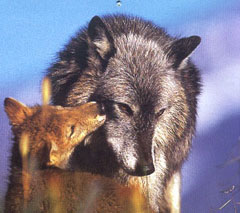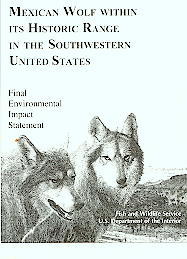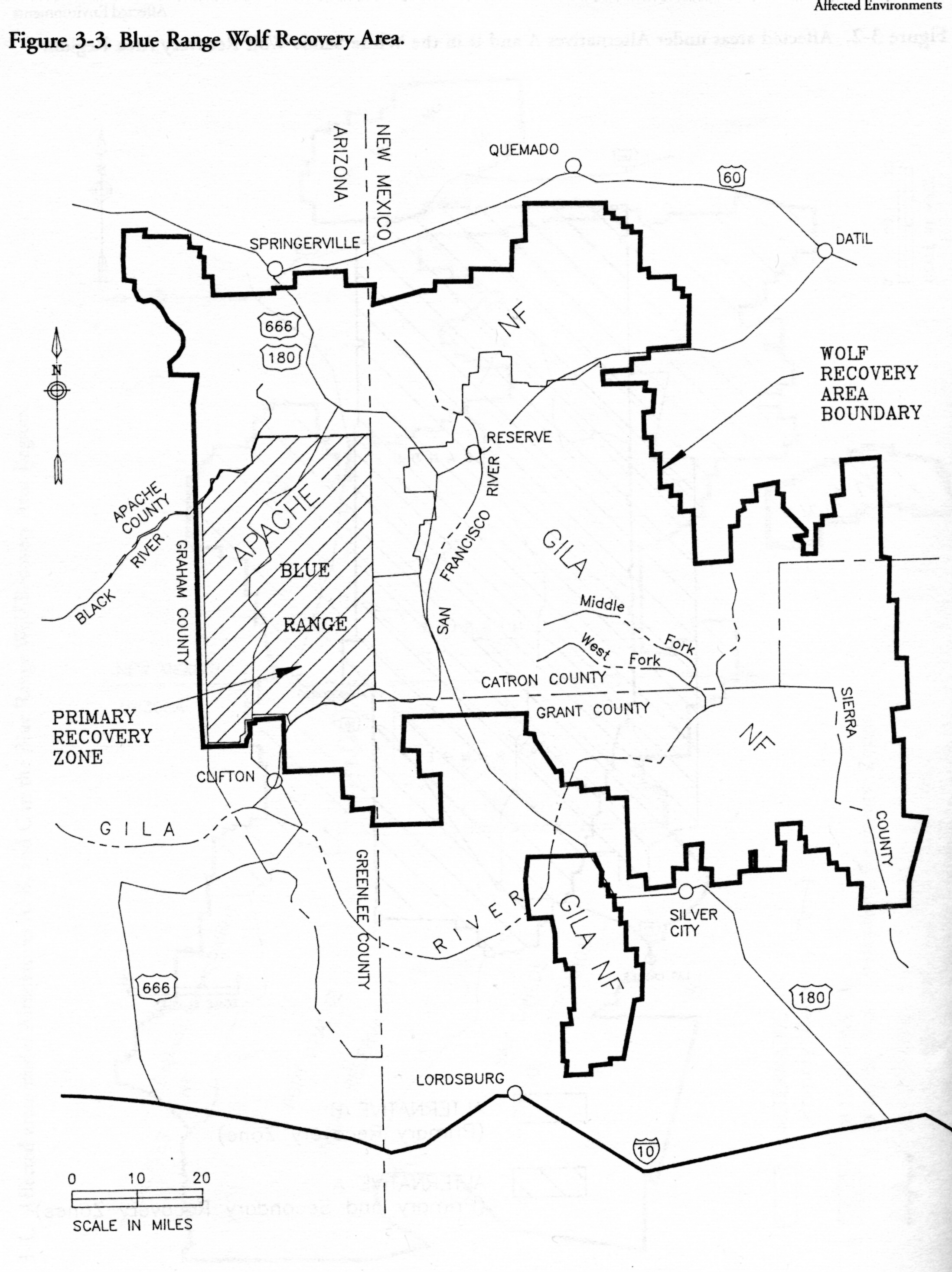The Mexican Wolf Reintroduction
Project
Understanding Diverse Viewpoints
Introduction
The Issue at Hand
The Mexican wolf used once roamed
throughout the Southwestern United States and Mexico. However, due
to an eradication plan supported up by the United States Biological
Survey in the early 1900's, the Mexican wolf was completely eliminated
from the United States. Only about 25 remained within Mexico (Brown).
With the passing of the Endangered Species Act in 1973, the remaining
Mexican wolves were captured and placed in captive breeding sites throughout
the nation, with the intention of reintroducing them into the wild.
In the meantime, the US Fish and Wildlife Service conducted extensive
research in preparation for the Environmental Impact Statement (EIS)
that was required for this reintroduction program under the National Environmental
Policy Act (NEPA)
. The Final Environmental Impact Statement (FEIS) was made available
to the public in November
1996. This document includes locations and
desired numbers of wolves for each reintroduction site. It defined habitat
distributions, management protocols and alternatives, and the ecological
assessment, describing the feasibility ofdifferent reinroduction sites
to sustain wolf populations. A major portion of the FEIS is devoted to
the effects the wolf will have on its surroundings, including the communities
of ranchers and Native Americans that utilize the land adjacent to
the the proposed reintroduction areas, located in the Apache and Gila
National Forests ("Reintroduction").
In 1998, with the support of Arizona and New
Mexico Game and Fish, and the help of leading wolf biologists, USFWS
released 11 Mexican wolves into the Apache National Forest in Arizona.
Since that time, USFWS has faced many difficulties, including devising
a management plan that was both politically and economically feasible.
The largest difficulty has been in appeasing the different stakeholders
involved and affected by the project. Some groups, like the ranchers
and Native American tribal members found in the areas surrounding the
introductions sites, have openly opposed the reintroduction. Other difficulties
have come from environmentalists, who have heavily criticized the management
protocols and have pushed for a more accessible public information
forum. Meanwhile the State Governments of Arizona and New Mexico have also
filed mixed reviews. As recently as March 29, 2002, New Mexico was threatening
to pull out of the project alltogether, and to permanently close the
gates of the Gila National Forest to the Mexican wolves ("New Mexico").
Under the Mexican wolf FEIS, the objective
of the USFWS is to establish establish a wild population of 100
individuals by 2005 within a 5,000 square mile recovery area, while
keeping 240 individuals in captivity to be used in maintaining genetic
viability ("Reintroduction," 1-1). However, despite the fact that the FEIS
focuses on the wolves, it often seems as if the federal government is more
concerned with meeting the desires of all the people affected than
to meeting the goals set up for the project. In the 21st century, with
a human population of over 6 billion, pristine areas no longer exist, for
all areas of the Earth are now somehow impacted either by human action or
by human thought (Allenby). Therefore, to truly be an effective manager
of any pristine area (or wildlife, in this case), it is important to
understand the human components that are involved in the management protocols.
The viability of the Mexican wolf population depends not only on the effectivenes
of the USFWS to execute a federal law; it also depends on the open-mindedness
of the people who live around the reintroduction area. These individuals
may feel that the security and control within their land is now threatened
by the return of an animal that they, or their ancestors, had helped to
eradicate.
In order to correctly manage the wolf within this human
sphere, we must understand the relationship between humans and the wolf.
In order to understand how to most effectively manage the Mexican wolf,
it is imperative to understand the thinking and motivation of the federal
government, the environmentalists, the ranchers and the Apache tribes.
The federal government has legal jurisdiction over the issue. The environmentalists
are the most passionate about the issue. The ranchers and Apache, local
citizens of the areas juxtaposing the reintroduction sites, are most
directly affected by the wolves, for it is these two groups who will have
most interaction with the wolves.
Brief History

The Mexican wolf (Canis lupus baileyi), otherwise
known as the Lobo, is the smallest, most genetically distinct
subspecies of the gray wolf. Historically, the Mexican wolf ranged throughout
the oak woodlands, mountain forests, grasslands and scrublands of America's
Southwest, in the states of Arizona, New Mexico, and Texas, and throughout
Mexico. However, with the increases in cattle numbers in the Southwest
in the late 1880's, conflicts between the lobo and cattle increased
in frequency. This quickly prompted the USBS to creation a plan that
called for the eradication of every single wolf throughout the United
States. Under the bureau's Predatory Animal and Rodent Control Service
(PARC), hunters were paid today's equivalent of $175 to either kill
or capture a wolf. Wolves were killed using traps, which came in different
shapes and sizes and were appropriately placed, anticipating a wolf's
movement. Denning was another favorite hunting techniques, whereby hunters
located active dens and killed the pups. Lastly, hunters also reduced
wolf number dramatically through their use of the the poison strychnine.
This method was actually one of the most efficient and cost effective,
for it required less maintenance than a trap did. Also, using strychnine
was much cheaper than sending out a hunter to kill three pups in a den,
for one application of this chemical could potentially kill a dozen or more
animals. In general, the eradication program was so successful that not
only were over 900 wolves killed in a single 10 year span from 1915 to 1925,
but, less than one hundred years later, every Mexican wolf within the United
States was dead. Only about 25 remained in Mexico (Brown).
However, with the passing
of the Endangered Species Act, steps were quickly taken to reestablish
the Mexican wolf population and reintroducethe wolf back into the
wild. The federal government, so implemental in the destruction of
the Mexican wolf, now became one of the main proponents for its return
to the Southwest. Using Mexican wolves acquired from Mexico, a captive
breeding program was set up amongst 24 zoos and wildlife sanctuaries
across the country. By 1996, the Final Environmental Impact Statement for
the Mexican wolf reintroduction was completed and released to the public,
signifying that the reintroduction program had officially begun ("Reintroduction,"
1-1 - 1-5).
On March 29, 1998, about 25 years since
they had been completely eradicated from the United States, and almost
brought to extinction, 11 Mexican wolves were released within the
primary recovery zone of the Apache National Forest in Arizona. Today,
having been returned to their native habitat, about 25 of them are once
again roaming free in the Southwest.
The Management Plan

The goal of the original plan, outlined in the Final Environmental Impact
Statement, is to establish a wild population of 100 individuals by 2005 within
a 5,000 square mile recovery area, while keeping 240 individuals in captivity
to be used in maintaining genetic viability. Under Alternative A, the option
that was adopted, the FWS designated the Blue Range Wolf Recovery Area
(BRWRA) as that area which includes the Apache National Forest, AZ and Gila
National Forest, NM (figure 1). The plan includes initial reintroduction of
the Mexican wolf into the primary recovery zone of the Blue Range Wolf Recovery
Area (figure 2) - the southwestern corner of BRWRA. The plan allows for up
to 15 families to be released within the area, and for the dispersal of these
wolves throughout BRWRA. The option has been left open for release of up to
5 families within the White Sands Wolf Recovery Area, located east of BRWRA.
The White Sands Recovery Area, NM includes the White Sands Missle Range, the
White Sands National Monument, the San Andres National Wildlife Refuge and
small portions of surrounding federal lands ("Reintroduction," 2-5 - 2-7).

FIGURE 1

FIGURE 2
Currently, the Mexican wolf is designated
as nonessential experimental, since the population currently in the wild
is not essential to the genetic viability of the species. This designation
has allowed the USFWS to have a more active management scheme, as
opposed to the management scheme adopted in the case of the endangered
Red Wolf in North Carolina. The red wolf is given more freedom to disperse,
and currently can be found within the Alligator River National
Wildlife Refuge in northeastern North Carolina and Great Smoky Mountains
National Park in the Southern Appalachian Mountains ("Red Wolf").
In the case that Mexican wolves disperse outside their designated reintroduction
area (the BRWRA), the USFWS must intervene and relocate them back
to the BRWRA. The federal government will not intervene only in
the case legal residents have allowed the wolves on their land ("Reintroduction,"
2-5 - 2-17). Recently, the area open to the
Mexican wolf has increased. On March 28, 2002
, the White Mountain Apache Tribe ruled to allow up to six wolves
onto 1.5 million acres
of land on their reservation ("White Mountain").
In addition to the active management plan, USFWS
have also adapted an "adaptive management approach" with regards to
the Mexican wolf reintroduction project. Under the adaptive management
strategy, USFWS is able to alter the management protocol based on professional
and public recommendations, and the results of research and monotoring
of the released wolves ("Reintroduction," 2-5 - 2-17).
|
|
|
|
| Author:
Yekaterina Gluzberg |
|
|
|
|
|
|
|
| Updated: 14 May 2002 |
|
|
|

 The goal of the original plan, outlined in the Final Environmental Impact
Statement, is to establish a wild population of 100 individuals by 2005 within
a 5,000 square mile recovery area, while keeping 240 individuals in captivity
to be used in maintaining genetic viability. Under Alternative A, the option
that was adopted, the FWS designated the Blue Range Wolf Recovery Area
(BRWRA) as that area which includes the Apache National Forest, AZ and Gila
National Forest, NM (figure 1). The plan includes initial reintroduction of
the Mexican wolf into the primary recovery zone of the Blue Range Wolf Recovery
Area (figure 2) - the southwestern corner of BRWRA. The plan allows for up
to 15 families to be released within the area, and for the dispersal of these
wolves throughout BRWRA. The option has been left open for release of up to
5 families within the White Sands Wolf Recovery Area, located east of BRWRA.
The White Sands Recovery Area, NM includes the White Sands Missle Range, the
White Sands National Monument, the San Andres National Wildlife Refuge and
small portions of surrounding federal lands ("Reintroduction," 2-5 - 2-7).
The goal of the original plan, outlined in the Final Environmental Impact
Statement, is to establish a wild population of 100 individuals by 2005 within
a 5,000 square mile recovery area, while keeping 240 individuals in captivity
to be used in maintaining genetic viability. Under Alternative A, the option
that was adopted, the FWS designated the Blue Range Wolf Recovery Area
(BRWRA) as that area which includes the Apache National Forest, AZ and Gila
National Forest, NM (figure 1). The plan includes initial reintroduction of
the Mexican wolf into the primary recovery zone of the Blue Range Wolf Recovery
Area (figure 2) - the southwestern corner of BRWRA. The plan allows for up
to 15 families to be released within the area, and for the dispersal of these
wolves throughout BRWRA. The option has been left open for release of up to
5 families within the White Sands Wolf Recovery Area, located east of BRWRA.
The White Sands Recovery Area, NM includes the White Sands Missle Range, the
White Sands National Monument, the San Andres National Wildlife Refuge and
small portions of surrounding federal lands ("Reintroduction," 2-5 - 2-7).
